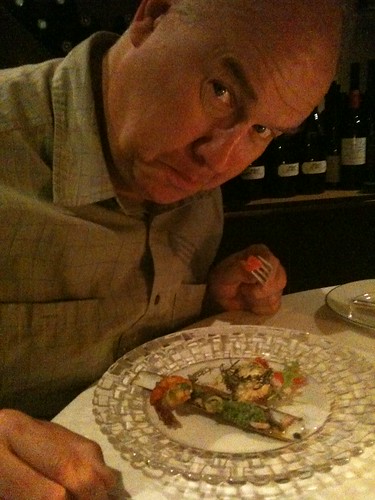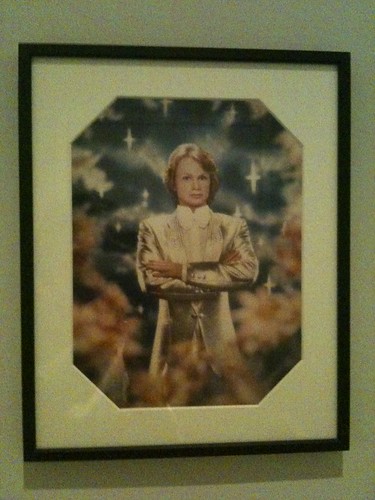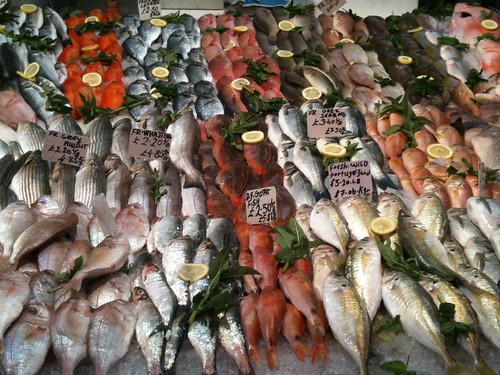It’s been Visit Pam time in London these last few weeks. First it was my sister and brother-in-law (they of last week’s Full English Breakfast), then close on their heels came a quick stop by Rob H (frequent blog commenter) and travelling companion Wes. They were over to participate in the First Night Riders charity motorcycle ride in aid of The Theatrical Guild. (It may still not be too late to sponsor…). Before the ride started Rob and Wes had one night in London which they decided to spend having fancy cocktails and even fancier food, and just to make things even more fun (or at least more fun for ME) they invited your humble blogger along. As Rob said in his email, “There are 3 choices for most courses, so you see, we NEED you so we can just plain order everything.” I was happy to oblige, though I admit I was somewhat intimidated when I saw that the place we went – the Gauthier Soho – actually had a Michelin star. I was scheduled to meet the visitors after a full day of work, but had last-minute jitters about my wardrobe choice and almost decided to forgo the pre-dinner cocktails to allow time to get home and change into something more posh (not to imply that my wardrobe has a vast selection of “more posh”, but I did think I could muster something a bit more appropriate). Then I remembered who I’d be dining with, and what they’d likely be wearing, and I relaxed and hopped the bus towards Liverpool Street to find the first venue of the night, a fancy cocktail bar.
Both the evening’s establishments had been exhaustively researched by Wes, the serious foodie in our midst. The cocktail place was called Lounge Bohemia (go ahead and click on that link and tell me if you can figure out how to get in…). It’s a place that specializes in a sort of molecular gastronomy style of cocktail making, meaning that while it’s possible to get a straight-up bottle of beer there, it’s much more fun to order something from the less traditional side. I tried a relatively tame combination of stout, raisin vodka and something else which was pleasant enough. Wes adventurously ordered some kind of tasting menu that purported to be a fresh take on old classics. When I arrived he was working on something that included a pile cotton candy made out of Amaretto (or possibly some other unlikely boozy ingredient) that he was twisting onto a swizzle stick and eating like, well, cotton candy. He also had a “White Russian”, which ended up being a small marshmallow infused with White Russian-ness served in a spoon of (I think) vodka. (Shades of “a single plum, floating in perfume, served in a man’s hat…). And then there was the margarita, which arrived as a pyramid of small salty bubbles called “salted air” and an aerosol container of margarita foam, leading to the quote of the night: “I hate it when you run out of salted air before you run out of margarita foam.” Rough life. And that was just the starters, we hadn’t even got to the restaurant yet.
Despite our late arrival at the restaurant, we were surprised to discover that our table was not ready. We were also surprised to find out that the restaurant did not have a bar, or a waiting area, or even a corner in which to crouch, so the Maitre D’ actually asked us (admittedly with a certain amount of bowing and scraping) if we would mind wandering around the neighbourhood for fifteen minutes or so. Instead, we hung around outside studying the menu and posing for photographs.
Once we were in it was magic. Our table was in a small room all by itself, except for about a zillion bottles of wine lining the walls, which we all thought was auspicious, especially when Wes said, ”I was thinking we should start with a prosecco…” just as a waiter appeared with three glasses of prosecco. It was like the place was bugged. Or perhaps they just give everyone a glass of prosecco when they sit down, especially if they’ve been forced to loiter in the streets while waiting for a table. Whatever the reason, it was cool. After the prosecco came a few tiny amuse-bouche, one of which was actually a foie gras macaron, and one which was a sort of layered dip with breadsticks, and one ceviche thing. And there was the waiter who came in with a tray the size of a parking space covered in about eight different types of rolls and breads. And this was all before we’d even ordered.
And now we run into the problem that if I were to describe everything we ate it would take a very very long time - Rob and I each had five courses and Wes had the tasting menu of seven, meaning we had about 15 different dishes (there were one or two repeats, like the black truffle risotto) and that doesn’t even include the extra bits that seemed to pop up frequently, and the second round of the giant bread tray and so on. It’s also slightly possible that you might tire of hearing the blow-by-blow description of each course, so let me just highlight a few of the, er, highlights:
 Rob, NOT demonstrating the “Are you kidding me?” face. I’m not sure what this face is, but he’s the one who kept exhorting me to put more pictures of people on the old blog, so he brought this on himself.
Rob, NOT demonstrating the “Are you kidding me?” face. I’m not sure what this face is, but he’s the one who kept exhorting me to put more pictures of people on the old blog, so he brought this on himself.
There were other things of course, and we all traded tastes back and forth so I got to sample just about everything on the menu. And following the prosecco there were, um, three bottles of wine, so it’s just possible that we may have reached the “jolly” stage by about the third course. That could be why I found myself taking a photo in the stall of the woman’s washroom. Or it could be that I couldn’t quite believe how remarkably gay the photo above the toilet was. And I don’t mean that in any kind of derogatory way, because really how else would you describe this?:
 Flamboyant, perhaps? (Later on there was a problem with the Ladies, so I was directed into the Gents toilet where I can report that the artwork was, if possible, even more gay.)
Flamboyant, perhaps? (Later on there was a problem with the Ladies, so I was directed into the Gents toilet where I can report that the artwork was, if possible, even more gay.)
I say that pre-dessert was the highlight, but really the whole evening was one big highlight. As Rob pointed out: we could have had a cracking night just hanging out in a pub eating fish & chips and enjoying the great company. Or we could have had an astounding meal with people who were annoying or stupid or just plain boring. Instead the food and the company were a perfect match, which raised the whole thing to another level. This meant that even though I had to be at work at 8:00 am the next day we lingered until the wait staff were hovering and trying not to get caught looking at their watches. We finally left some time after midnight and weaved through the West End towards Leicester Square tube station, where I ended up getting the last train home to Brixton and fell into bed in a state of perfect contentment.
A truly excellent outing. The only other thing I can say is: Thank you Rob and thank you Wes, for coming over in the first place, and for making the time to visit with me, and for inviting me along for such a memorable evening. Come back again any time. Next time the first round of thymus is on me.
Both the evening’s establishments had been exhaustively researched by Wes, the serious foodie in our midst. The cocktail place was called Lounge Bohemia (go ahead and click on that link and tell me if you can figure out how to get in…). It’s a place that specializes in a sort of molecular gastronomy style of cocktail making, meaning that while it’s possible to get a straight-up bottle of beer there, it’s much more fun to order something from the less traditional side. I tried a relatively tame combination of stout, raisin vodka and something else which was pleasant enough. Wes adventurously ordered some kind of tasting menu that purported to be a fresh take on old classics. When I arrived he was working on something that included a pile cotton candy made out of Amaretto (or possibly some other unlikely boozy ingredient) that he was twisting onto a swizzle stick and eating like, well, cotton candy. He also had a “White Russian”, which ended up being a small marshmallow infused with White Russian-ness served in a spoon of (I think) vodka. (Shades of “a single plum, floating in perfume, served in a man’s hat…). And then there was the margarita, which arrived as a pyramid of small salty bubbles called “salted air” and an aerosol container of margarita foam, leading to the quote of the night: “I hate it when you run out of salted air before you run out of margarita foam.” Rough life. And that was just the starters, we hadn’t even got to the restaurant yet.
Despite our late arrival at the restaurant, we were surprised to discover that our table was not ready. We were also surprised to find out that the restaurant did not have a bar, or a waiting area, or even a corner in which to crouch, so the Maitre D’ actually asked us (admittedly with a certain amount of bowing and scraping) if we would mind wandering around the neighbourhood for fifteen minutes or so. Instead, we hung around outside studying the menu and posing for photographs.
Once we were in it was magic. Our table was in a small room all by itself, except for about a zillion bottles of wine lining the walls, which we all thought was auspicious, especially when Wes said, ”I was thinking we should start with a prosecco…” just as a waiter appeared with three glasses of prosecco. It was like the place was bugged. Or perhaps they just give everyone a glass of prosecco when they sit down, especially if they’ve been forced to loiter in the streets while waiting for a table. Whatever the reason, it was cool. After the prosecco came a few tiny amuse-bouche, one of which was actually a foie gras macaron, and one which was a sort of layered dip with breadsticks, and one ceviche thing. And there was the waiter who came in with a tray the size of a parking space covered in about eight different types of rolls and breads. And this was all before we’d even ordered.
And now we run into the problem that if I were to describe everything we ate it would take a very very long time - Rob and I each had five courses and Wes had the tasting menu of seven, meaning we had about 15 different dishes (there were one or two repeats, like the black truffle risotto) and that doesn’t even include the extra bits that seemed to pop up frequently, and the second round of the giant bread tray and so on. It’s also slightly possible that you might tire of hearing the blow-by-blow description of each course, so let me just highlight a few of the, er, highlights:
- I tried sweetbreads! They were quite mild tasting, and not terribly organ-y at all. The consistency was more like lobster tail than anything.
- I also tried foie gras for the first time. Yes, I know it’s horrible for the goose involved, but I think trying it once is fair enough. In fact, I found it so rich that it was almost like slicing into a slab of butter so I’m not sure I actually need to have foie gras again.
- There was a seafood dish that featured smoked sea bass and a langoustine that was so sweet and tender that it made me make that sort of disbelieving “Are you kidding me?” face, and then slice off a small portion for Rob to try, who also promptly made the “Are you kidding me?” face. There was a lot of that going around all night.
 Rob, NOT demonstrating the “Are you kidding me?” face. I’m not sure what this face is, but he’s the one who kept exhorting me to put more pictures of people on the old blog, so he brought this on himself.
Rob, NOT demonstrating the “Are you kidding me?” face. I’m not sure what this face is, but he’s the one who kept exhorting me to put more pictures of people on the old blog, so he brought this on himself.There were other things of course, and we all traded tastes back and forth so I got to sample just about everything on the menu. And following the prosecco there were, um, three bottles of wine, so it’s just possible that we may have reached the “jolly” stage by about the third course. That could be why I found myself taking a photo in the stall of the woman’s washroom. Or it could be that I couldn’t quite believe how remarkably gay the photo above the toilet was. And I don’t mean that in any kind of derogatory way, because really how else would you describe this?:
 Flamboyant, perhaps? (Later on there was a problem with the Ladies, so I was directed into the Gents toilet where I can report that the artwork was, if possible, even more gay.)
Flamboyant, perhaps? (Later on there was a problem with the Ladies, so I was directed into the Gents toilet where I can report that the artwork was, if possible, even more gay.)
The highlight, though, must have been when the waiters swooped in some time after the fourth course (pigeon), and the Maitre D’ introduced me to my new favourite word: PRE-DESSERT! How can it be that I’ve reached 42 years of age and never been privy to the concept of the pre-dessert? It’s so elegantly simple. I mean it’s clear that if one dessert is good, then two dessert must be double good, so why not simply slide in a bit of pre-dessert before the main event? It makes perfect sense. My first-ever pre-dessert was a sort of deconstructed cherry crumble with sour cherries in a warm sauce sprinkled with bits of spicy crumble. And that was before the dessert I’d actually ordered which was a chocolate thing (of course) that was so densely chocolatey that it was like a black hole of chocolate, which was then perched on top of a disc of crunchy praline. With gold leaf.
I say that pre-dessert was the highlight, but really the whole evening was one big highlight. As Rob pointed out: we could have had a cracking night just hanging out in a pub eating fish & chips and enjoying the great company. Or we could have had an astounding meal with people who were annoying or stupid or just plain boring. Instead the food and the company were a perfect match, which raised the whole thing to another level. This meant that even though I had to be at work at 8:00 am the next day we lingered until the wait staff were hovering and trying not to get caught looking at their watches. We finally left some time after midnight and weaved through the West End towards Leicester Square tube station, where I ended up getting the last train home to Brixton and fell into bed in a state of perfect contentment.
A truly excellent outing. The only other thing I can say is: Thank you Rob and thank you Wes, for coming over in the first place, and for making the time to visit with me, and for inviting me along for such a memorable evening. Come back again any time. Next time the first round of thymus is on me.























